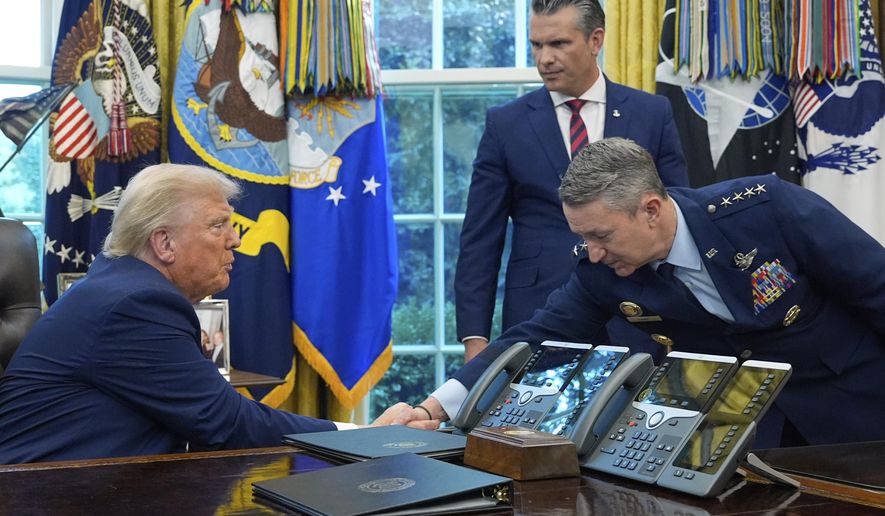The Moral Vision to Save Lives in a Dangerous World

Jed Babbin| June 2, 2025
(The Washington Times) — When President Reagan announced his Strategic Defense Initiative in 1983, he posed a moral question. Is it better, he asked, to protect lives or to avenge them? Asking that question toppled our and our enemies’ entire theory of defense. Instead of “mutually assured destruction,” we began thinking about creating an effective defense against ballistic missiles.
Reagan’s plan never came to fruition. Democrats mocked it, calling it “Star Wars.” The funding didn’t come, and the technology wasn’t ready for a real missile defense.
President Trump is facing a vastly different set of threats than Reagan faced. The president’s idea for a Golden Dome missile defense certainly arose from Israel’s Iron Dome defenses, which include Iron Dome, David’s Sling and Arrow interceptors. Although these are not perfect, they have enormously reduced Israel’s enemies’ ability to attack it with rockets and missiles. The Iron Dome has an excellent record of interceptions, though a few rockets and missiles still get through.
Mr. Trump’s idea, which he announced last month, is for a similar layered missile defense.
The architecture of the Golden Dome system comprises a layered defense, which is made up of three types of interceptors: short range, midrange and long range. Mr. Trump’s plan requires interceptors to be based in space, which will be our first weapons in orbit.
The threats Mr. Trump’s plan faces are different from those Reagan planned to answer. Not only the Russians have nuclear-armed missiles capable of reaching us, but so do the Chinese and North Koreans. The Iranians may soon join the club.
The missile threats are also different from what they were in 1983. Ballistic missiles have been modernized, and newer hypersonic and cruise missiles are capable of shifting targets in midflight. There is also the theory that hypersonic missiles generate a “plasma cloud” around them, making them essentially invisible to radar. (One Pentagon expert on hypersonic missiles I spoke with last year said the “plasma cloud” is theoretical, but until the theory is disproved, the problem remains.)
China and Russia have condemned Mr. Trump’s idea, saying it would be deeply destabilizing. They said in a joint statement that Mr. Trump’s plan would turn “outer space … into an arena of military confrontation” and a location “to place weapons.” That’s nothing less than a backhanded endorsement of the president’s plan.
Russia, as this column wrote last year, may be planning to orbit nuclear weapons to kill our satellites. That would be more destabilizing than any plan the president has. Our anti-satellite capabilities are minimal, and Russia’s and China’s are not. We will have to orbit a vast array of additional satellites and hunter-killer satellites to protect them.
Canada has endorsed the plan and wants to be included in its defensive shield. It should have to contribute billions of dollars for being protected by our system.
The system Mr. Trump plans to build will, according to his estimate, cost $175 billion, the first $25 billion being funded under his “big, beautiful” reconciliation bill. (The Congressional Budget Office projects the cost to exceed $540 billion over the next 20 years.) Mr. Trump wants the system to be deployed before he leaves office. Given our constipated weapons acquisition system, Mr. Trump’s proposal may be impossible to complete before 2029.
The whole of Mr. Trump’s plan has been put under the control of the U.S. Space Force, with Gen. Michael Guetlein designated program manager. Gen. Guetlein has a huge task to perform. Major contractors are already lining up to get a piece of the action. As this column has written before, the acquisition system requires so many time-wasting studies, audits and such that it compels long delays. Gen. Guetlein should be given orders to throw out the parts of the acquisition system that will prevent him from meeting Mr. Trump’s deadline. He may have to go to Congress to get permission to cut the necessary corners.
Some of the systems already exist, and many others need to be built or built up. All of them need to be integrated under one command and control structure. For example, our Space-Based Infrared System satellites are capable of detecting launches of everything from large ballistic missiles to small aircraft-fired missiles.
Another example is our number of ground-based missile interceptors at Vandenberg Air Force Base in California and in Greely, Alaska. The Space-Based Infrared System, the ground-based interceptors and many other assets must be included in the overall command structure.
Space-based interceptors are a new ballgame for the U.S., as are the hunter-killer satellites necessary to protect them. New technologies are capable of performing this mission, but can they be developed in time to deploy the system before 2029?
In short, it’s highly doubtful that the Golden Dome can be deployed before 2029. It will take a series of near miracles and a lot of luck to do so. Nevertheless, we need Mr. Trump’s plan to become a reality. It is, as Reagan implied, far more moral to save lives than to avenge them.
Jed Babbin is a national security and foreign affairs columnist for The Washington Times and a contributing editor for The American Spectator.




















